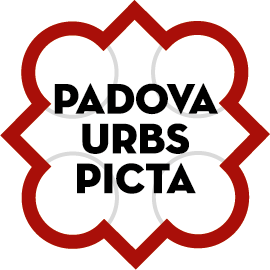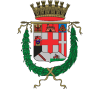Prato della Valle: “Up to the middle of the last century, the only positive thing to be said about this area was its size, within which were comprised the ruins of a Roman theatre (the Zairo), the church of Santa Giustina, the monastery of wealthy Benedictine monks and various historical associations. Damp and marshy, it was full of stagnant water and reeds that were a breeding-ground for insects. The Venetian provveditore Andrea Memmo changed all this, making it a delightful place.” so said Pietro Chevalier in 1831.
The Prato della Valle he is referring to – that is, as it existed prior to Memmo’s 1744 land-reclamation project – can actually be seen in various engravings by Canaletto. The result of Memmo’s work was to transform a wasteland into the largest city square in Western Europe, measuring 88,620 m2. At the centre of the square is the elliptical Isola Memmi, which is reached by four symmetrically placed bridges; two with obelisks, one with four statues of popes, and one with no statues at all. The narrow channel around the island is fed with water from the river Bacchiglione, which after passing under the bridge of Porta Santa Croce and then round the associated bastion, flows underground along Via 58. Reggimento Fanteria Abruzzi and comes out near the bridge with the statues of popes. Both banks of the channel are lined with a total of 78 stone statues which commemorate figures who were in some way linked with the city and its university. At the junction of the two avenues that run at right-angles across the island is a large fountain. The presence of the statues led to the square initially being called Piazza delle Statue (before being renamed Piazza Vittorio Emanuele and subsequently being known solely by its present title). Each of the statues has a number inscribed on its pedestal. Number 85 (on the inner bank of the channel), for example, depicts Andrea Briosco, a Padua sculptor who died in 1532, with a bust of the Paduan poet Gaspara Stampa (1523-1554) at his feet; she is the only female figure honoured by these statues. For those arriving from Via Umberto I, the street numbers in Prato della Valle run clockwise, number 1 being the fifteenth-century Palazzo Angeli, which used to be the home of Andrea Memmo and his English mistress, Lady Giustiniana Wynnie. Since 1998 the building has been home to the very interesting Minici-Zotti collection of pre-cinema technology. Within the portico is a sixteenth-century fresco of The Annunciation. At number 9 is Palazzo Sartori-Morassutti (formerly Palazzo Vendramin-Calergi) where, as commemorated by a plaque on the facade, King Vittorio Emanuele II stayed on 1 August 1866. At number 21-22 is a house built in 1434 for Palla Strozzi, a Florentine humanist who was exiled to Padua, where he died in 1462. The area alongside was the site of the church of Santa Maria di Betlemme, run by Augustinian nuns. At number 23-24 is a small corner building with an annexed hospital for the blind, which was founded in 1441. In Via Luca Belludi, one can see small apartment buildings designed by Agno Berlese (1922-30), which have been described in these terms: “the narrow two-light windows, the small balconies, the extensive use of polychrome decoration and, above all, the small corner tower, create a combination of the neo-medievalist and some aspects of Art Deco, which reflects the taste of the time.” 29 Prato della Valle is Casa Brunetta (1962), which preserves the external appearance of the house that existed here before. Inside, the engineer/architect Giulio Brunetta totally reconstructed the space, thanks to a modern design that overcame the limits of the long narrow site; expanding upwards, he left a large open space at the centre of the building, so that natural light is received at both the back and the front of all the apartments within, which extend over different levels and floors.
At number 41-44 is the Casa degli Armeni (now Palazzo Tonzig). This was the site of the large stable that provided night lodging for all the animals brought here for the Fair of St. Anthony; the building would then house the Teatro del Recinto [The Boundary Theatre] – also known as the Teatro Vacca [Cow Theatre] – in the years 1778-1792. The wealthy Armenian who gave the current building its original name was called Abramo Aganoor, and he built this home for himself after coming to Padua from Persia; the house would be the birthplace of the poet Vittoria Aganoor (1855-1910). Behind the old Stables was the Oratory of San Leolino or Leonino (known popularly in Padua as ‘San Violin’), with the Chapel of San Michele alongside; both buildings long gone. The site also housed the Scuola delle mammane o delle comari [School for Midwives], which – in the words of an eighteenth-century document – was intended “for the training of 12 women of this State, who having been approved as proficient are to be sent back to their towns to practice obstetrics.” The circuit of Prato della Valle now brings you to the Basilica of Santa Giustina and the Benedictine monastery. The basilica is the ninth largest in the world, reaching a height of 120 metres. The bare and unfinished facade has four niches; each contains a statue of one of the Evangelists by the modern sculptor Novello Finotti. To the side of the steps up to the entrance are two griffins in red marble, which made such an impression upon Théophile Gautier when he visited Padua in 1852. The simplicity of the facade may mislead the visitor as to what to expect upon entering. However, as Pietro Chevalier commented in 1831, “there is something lacking in those who can wander down these wide naves, these crossings between aisle and transept, and not respond to their majestic nature; not feel a sense of amazement and admiration well up within their soul.” In the Chapel of St. Luke is the tomb containing the mortal remains of the Evangelist. The work is by a Veneto sculptor and was commissioned in 1313 by Abbot Gualpertino Mussato. Above is a sixteenth-century copy of the icon known as The Madonna of Constantinople. The frame of this is by Amleto Sartori (1960), as are the two angels in flight and the eight-branch candelabra in bronze. In the wing of the monastery that gives onto Prato della Valle, at number 64, are the premises of the Regional Military Command for North-East Italy. Within that wing are also the Chiostro della Porta [Gate Cloister] and the Chiostro Dipinto [Painted Cloister], the paintings in the latter recounting Scenes from the Life of St. Benedict. At number 71 is the former Foro Boario, which stands on land that was once owned by the Armenian Mekhitarist Fathers. Built in 1913-14 by the engineer Alessandro Peretti, this has a central facade arch flanked by two pairs of columns supporting the pediment, which is decorated with “a Market Scene” by the Paduan Antonio Penello. This was once the site of the Benedictine convent of Our Lady of Pity [misericordia]; the present building, originally used as a livestock market, houses an interesting naval museum. At 80-81 is the imposing Palazzo Grimani (now known as Palazzo Verson), which stands at the corner with Corso Vittorio Emanuele.
Over the years 1520 and 1556, the Grimani family bought up houses on this site and then began work on their palazzo. In 1621-1630, Francesco Grimani undertook further work on the building, commissioning designs from the proto [master builder] Francesco Contin. At number 82, on the corner with Via Alberto Cavalletto, is Palazzo Zacco, which now houses a Military Officers Club. Once the property of the Armenian Mekhitarist Fathers, the building housed the Collegio Moorat, a school for Armenian students. The structure has a seven-arch arcade of rusticated columns, with a cornice adorned with obelisks and lunettes. It was completed in 1556-57, to designs by Andra Moroni. At number 88 is Palazzo Duodo, now the headquarters of the Carabinieri. At number 99 is the Loggia Amulea. Known as “the stone stage set” , this was once a school for the children of the nobility which, founded by Cardinal Antonio Da Mula (or Amuleo], was destroyed by fire in 1822. The City Council then decided to commission a design for a palazzo with a facade loggia, which was to serve as the residence of the general commanding the Second Military Corps of Lombardy-Veneto. Those designs were drawn up by Jappelli, but the actual building work was overseen by the engineer Eugenio Maestri. The pillars of the loggia are in red and yellow marble, with the rest of the facade in brickwork of Costozza stone; the sculptor Antonio Gradenigo did the work on the stone mouldings and other decorative features. In 1965, to mark the 600th anniversary of Dante, statues of the poet and of Giotto, by the sculptor Vincenzo Vela, were placed within the portico. At number 105 is the fine Palazzo Duse-Masin, whose interior contains neo-classical frescoes by Gian Carlo Bevilacqua, Giovanni Demin, Francesco Hayez and Pietro Moro. At number 109 is the opening into a narrow cul-de-sac. Padua has many examples of such cul-de sacs and open-ended courtyards leading off main streets; used as public spaces, these were a traditional feature of medieval city planning. Continuing under the porticos you move into Via Umberto I.
At number 126 of that street is a house with an early-nineteenth century classical colonnade. This was part of the route of the Acquette Canal, which flowed from Via Dimesse, through the modern-day Via Acquette and then along what is now Vicolo Tabacco. In Via San Daniele (now incorporated into Via Umberto I) was the Mulini di Prato della Valle bridge, whose name reflects that a number of water-powered mills [mulini] were in operation here.
At number 100 is Casa Da Zara; owned by the Risorgimento patriot Paolo da Zara, this was where Giuseppe Garibaldi stayed on the 5-6 March 1867. Almost directly opposite is the church of San Daniele. The original place of worship on this site was built to commemorate the fact that, during the transfer of the Paduan martyr’s remains from Santa Giustina to the Cathedral crypt, the procession had to stop at this point as the saint’s coffin suddenly became immoveable; the present church dates from 1706, with the facade by Agostino Rinaldi (18th-19th century). In the niches are statues of St. Daniel and St. Giustina by the Paduan sculptor Francesco Rizzi (1739- 180?). On the right wall is a plaque raised by Canon Giovanni Battista Rota (1560) which commemorates that the spot once held the tomb of the brilliant local playwright Angelo Beolco (better known as ‘Il Ruzzante’). At number 82 is Palazzo Emo Capodilista; this dates back to the thirteenth century and is the oldest private residence in the city which still has an intact medieval tower. The round-arched porticoes are decorated with frescoes, yet with its bare brick facade the building has something of the air of a well-fortified castle. The main doorway dates from 1767. As a plaque here records, one of those who passed through this doorway as guests of the owners was Duke Amedeo di Savoia, the second son of king Emanuel II; this happened in August 1866, after the duke had been wounded at the battle of Custoza between the Italian army and the forces of Napoleon III. At number 69 is the Casino Capodilista, which was built in 1781; a two-floor building set in a small garden, this was designed by Giovan Battista Novello. At number 46 is Palazzo Venturini, with a typical fifteenth-century design rising above a portico of three wide arches. The small Palazzo Dottori at number 36 has a three-light window, and the neoclassical Casa Munari at number 27 is attributed to the Venetian architect Gian Antonio Selva. The Casa Olzignani at number 8, was built in 1466 by the architect Pietro Lombardo, and has been described as revealing his “superb mastery, refined taste, originality and artistic sensibility”.
The whole facade is symmetrical, with a large central four-light window and side windows on the first floor, and a small two-light window flanked by square windows on the second floor; at ground level is an arcade with small capitals and flattened arches. This gem of a building in Nanto stone has unfortunately suffered a great deal from exposure to the elements. At number 6 is the eighteenth-century Casa Valmarana, which is attributed to the architect Francesco Muttoni; one side of this gives onto the canal of Santa Chiara and has a gateway for river traffic; all of the houses along the, now covered, Naviglio waterway, had such gates, which facilitated the loading and unloading of both goods and passengers, Via Umberto I ends at the Torricelle bridge: the city gateway that went with that bridge was demolished in 1819, when this stretch of the medieval city walls was pulled down. A plaque here recalls “Ezzelino/entering as victor and tyrant/ here removed his helmet/ and avidly kissed/ the gate to the city”. Continuing down Via Roma, you soon come to the church of the Nativity of the Virgin, also known as Santa Maria dei Servi. In 1372 – at a time when the arts were flourishing in Padua – this church was commissioned by Fina Buzzaccarini, wife of Francesco ‘Il Vecchio’ da Carrara. Upon the death of Fina, her son – Francesco ‘Novello’ da Carrara – would grant the church to the Servi di Maria [the Servites], a religious order that had been founded in Florence and received papal approval in 1304; thereafter it was known by its present name. Later, a Servite monastery would be built nearby, though only a few traces remain; one person who lived there for a time was the Veneto’s most famous Servite: Fra Paolo Sarpi, a great opponent of the excessive power of the papacy. Access to the church is by a side door under a portico; the elegant arches (1511) rest on columns of red Verona marble that came from the demolished fourteenth-century Chapel of St Anthony’s Tomb in the Basilica of St. Anthony. The north –wall of the church – that running along Via Roma – has fourteenth-century brickwork and stone decoration, whilst the west wall has two splendid terracotta lintels and two rose windows (one Gothic, one Renaissance). To the right of the church is also a bell-tower with large two-light openings on all four sides. When the Servite monastery existed, the church was also linked to two oratories: one was known as The Good Man Confraternity of Tailors and the other belonged to the Confraternity of Santa Maria del Parto [Our Lady of the Birth]. In the small square in front of the church, at number 83-87, was the small church of Sant’Egidio, which was the place of worship of the Fraglia dei Marzari [Confraternity of Mercers].
On the walls of number 70 are traces of grafitti images depicting biblical scenes, whilst at number 61 is the Banca d’Italia. This site had been occupied by a nineteenth-century building which was demolished for work to begin on this bank in 1968, to designs by Giuseppe and Alberto Samonà; building was completed in 1974. The main entrance is in the alleyway that runs parallel to Passaggio Tito Livio, whilst the side that gives onto Via Roma itself is intended to reflect a typical Paduan street of porticoes with rounded arches. Both inside and outside, the surfaces are in bare concrete, with no false ceilings covering the building materials. Casa Da Zara-Mazzoleni, at number 44, has a four-light window on the first floor and four single-light windows on the second; this was the birthplace (on 11 August 1888) of Baron Leonino Da Zara, who at the nearby town of Bovolenta would construct one of the first aerodromes in Italy. One side of the small square at number 13 was once occupied by the facade of the church of Santa Giuliana, later Santa Apollonia, which was the place of worship of the Confraternity of Goldsmiths. Subsequently, the building would house the printworks of the Selmin Brothers.
In operation up to 1916, this firm would produce the smallest ever edition of Dante’s Divine Comedy; published in 1878, the book became known by the diminutive “Il Dantino” and measured 38 by 21 millimetres. Via Roma ends at Canton del Gallo [Cockerel Corner], which for many years challenged Caffè Pedrocchi as the centre of city life; the name comes from an old hostelry or workshop here that was “by the sign of the cockerel”. Via Roma itself was originally the result of linking up the short Via Sant’Apollonia, Via Santa Giuliana, Via dei Servi and Via Sant’Egidio. It was in Via Sant’Egidio that a very young Giacomo Casanova lived while studying under Doctor Antonio Mario Gozzi, prior to graduating from Padua university in 1742. In the words of Bruno Brunelli-Bonetti, the later Casanova would recognise that the good doctor’s “pretty, joyous and flirtatious” sister, Bettina, had been “his first teacher in a discipline within which he himself would rise to the rank of a famous professor.”
- DISCOVER
- LIVE
FOCUS
- GET INSPIRED
FOCUS
- INFO
- BOOK NOW












